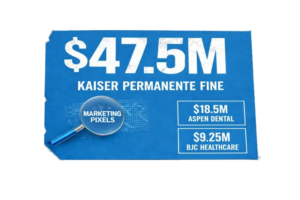Web Tracking Tested: 7 Risky Practices You Need to Avoid

What is Web Tracking?
Web tracking refers to the practice of collecting, analyzing, and storing information about a user’s interactions with websites, applications, or online services. It typically involves gathering data like browsing behavior, device identifiers, IP addresses, and consent.
Web tracking sometimes attracts criticism for compromising user privacy, but here are some of the legitimate and beneficial reasons why it’s used:
Website Functionality: Essential web tracking, such as using session cookies, ensures that websites work properly. They keep users logged in, remember items in shopping carts, and maintain language preferences.
Security and Fraud Prevention: Web tracking is necessary to detect suspicious activity, prevent unauthorized logins, identify bots, and defeat fraud attempts such as credit card theft.
Analytics and Performance Measurement: Understanding how visitors use a site (using metrics like page views, navigation paths, and load times) helps businesses improve accessibility, usability, and performance.
Personalization: User tracking helps with presenting relevant content, product recommendations, or shaping user experiences that are tailored to their preferences.
Privacy Compliance and Legal Obligations: Web tracking may be required for audit trails, regulatory reporting, or managing user consent obligations under laws like GDPR, CCPA, and others.
Advertising (when users consent): Pixels and cookies help marketers target consumers with relevant advertising. Unlike essential tracking, advertising tracking is typically based on user consent and helps marketers deliver relevant ads. It’s essential to manage pixels and cookies safely, which is something that Reflectiz can help you do.
Web Tracking: Seven Risky Practices To Avoid
Consumers are increasingly aware of how their online activities are being tracked and monetized, with many now demanding greater transparency and control over their personal information. Regulators have listened to their concerns and beefed up their requirements in response, so as a website owner, this means you have an important balancing act to maintain. You want to use web tracking to get the information you need, but you also want to maintain user confidence and comply with privacy regulations. Well, you can achieve all three by avoiding the seven risky practices that we outline in this article:
1. Web tracking without consent
2. Undisclosed cross-site tracking
3. Collecting excessive personal data
4. Storing web tracking data insecurely
5. Sharing data with unknown third parties
6. Tracking sensitive categories
7. Ignoring user opt-out requests
Let’s look at each one in turn, and then what to do to avoid them.
1. Tracking without consent – GDPR/CCPA violations, lack of cookie banners
In Europe, collecting non-essential data through cookies or similar technologies without prior consent violates the ePrivacy Directive and GDPR principles. In California, the rules differ: the CCPA/CPRA give users the right to opt out of the sale or sharing of personal information, including cross-context behavioral advertising. In the EU, websites must obtain clear, informed consent before storing or accessing non-essential cookies. In California, the obligation is instead to provide clear notice and an easy way for users to opt out of the sale or sharing of their data.
Web tracking without consent can erode user trust and lead to reputational damage, but it’s an area where the Reflectiz privacy dashboard can help. The system detects instances where proper consent for cookies hasn’t been obtained and issues prompt alerts to keep sites secure, as it did in this case.
Legitimate web tracking must start with user consent, clear disclosures, and meaningful choices, so, to avoid web tracking without consent:
- Always deploy a clear, accessible cookie banner with “Accept” and “Reject” options that are equally prominent.
- Use granular consent (e.g., essential cookies, analytics, advertising) instead of a blanket yes/no.
- Regularly audit your consent mechanisms to ensure compliance with GDPR, CCPA, and other regional laws.
- Store proof of consent (time, method, choices made) for audit purposes.
- Consider using Consent Management Platforms (CMPs) like OneTrust or Cookiebot to help users understand how to implement granular consent.
2. Undisclosed Cross-Site Tracking – Third-party cookies, fingerprinting
Cross-site tracking involves following users across multiple websites to build detailed profiles of their behavior, interests, and demographics, often using third-party cookies or browser fingerprinting (combining device and browser settings to create a unique user identifier). While modern browsers like Safari and Firefox include anti-fingerprinting measures, these methods can still be invasive if they aren’t disclosed.
Under EU law, placing or accessing third-party cookies or using fingerprinting generally requires explicit, informed consent under the ePrivacy Directive, and the GDPR then applies to the downstream use of that personal data. Undisclosed cross-site tracking can lead to manipulative advertising or discriminatory pricing, which users don’t appreciate.
To avoid tracking without disclosure and keep them on-side:
- Maintain a clear, public list of all third-party web trackers used on your site.
- Disclose how cross-site data is used in your privacy policy, in plain language.
- Implement CMPs to capture user approval for third-party cookies.
- Explore privacy-friendly alternatives to third-party web tracking, such as server-side analytics.
3. Collecting excessive personal data – Going beyond what’s necessary
One of the key principles in modern privacy law is data minimization, which says that organizations should only collect data that is strictly necessary for the stated purpose. Excessive user tracking,such as gathering full browsing histories, GPS locations, or unrelated personal identifiers,violates this principle. Not only does it increase compliance risks, but it also heightens exposure in case of a data breach. For example, a simple online store may only need to track purchase history and shipping addresses, rather than detailed location data or social media profiles, so if a breach happens, that additional data raises the severity of the violation for the store owner.
Ways to avoid collecting excess data:
- Apply the data minimization principle: only collect what’s strictly necessary. Audit your data collection points to ensure you are only asking for data strictly needed for the service provided (e.g., don’t ask for a user’s birthday if you don’t offer birthday discounts).
- Map your data collection flows and justify each data point against business needs.
- Regularly review and delete unnecessary data to reduce risk.
- Involve your privacy or compliance team when designing new tracking mechanisms , and remember, under GDPR a formal Data Protection Officer (DPO) is only mandatory for certain organizations (like those doing large-scale monitoring).
- Use the Reflectiz privacy dashboard to ensure that tracking technologies aren’t collecting more data than they should.
4. Storing web tracking data insecurely – Poor data protection practices
Even if web tracking is conducted lawfully, storing the collected data without proper safeguards creates serious risks. Poor practices like keeping unencrypted databases, having weak access controls, or relying on outdated software make user data a prime target for cybercriminals. A breach can expose sensitive information like browsing habits, identifiers, and even financial details.
Under laws like GDPR, organizations have a legal duty to implement “appropriate technical and organizational measures” to secure personal data. Insecure storage not only leads to fines but again, can also undermine brand reputation and customer loyalty. Ethical web tracking requires not just lawful collection but also robust protection of the data lifecycle, so to avoid storing user web tracking data insecurely:
- Apply strong encryption for personal data both at rest and in transit , while the GDPR doesn’t mandate specific algorithms, widely adopted standards like AES-256 and TLS 1.3 are considered best practice.
- Regularly and securely delete data that is no longer needed.
- Enforce role-based access controls (RBAC) and monitor usage logs.
- Regularly test and assess your security measures , penetration testing and audits are common ways to satisfy GDPR’s requirement for ongoing evaluation.
- Require all vendors and partners to comply with recognized security frameworks (like ISO 27001 or SOC 2, etc.).
5. Sharing data with unknown third parties – Lack of vendor vetting
Many organizations use third-party vendors,advertisers, analytics providers, cloud platforms,for web tracking and data processing, but sharing user data with these parties when they haven’t been properly vetted is a major privacy compliance risk.
GDPR requires controllers to have data processing agreements (DPAs) with processors and to ensure they provide “sufficient guarantees” of privacy and security before any data sharing. Without this, organizations risk exposing user data to unknown or untrustworthy entities.
Ethical practice involves maintaining a clear vendor register, conducting regular audits, and limiting data sharing to vetted, necessary partners only. Transparency is key here,users should know who their data is shared with and for what purpose. To avoid sharing data with unknown third parties:
- Maintain a vendor register with details on who has access to user data and why.
- Conduct due diligence checks on all third-party providers before onboarding.
- Sign data processing agreements (DPAs), which are legal contracts that outline the vendor’s responsibilities to protect user data.
- Use data flow diagrams to visualize and monitor where data travels. Reflectiz can help here as it maps data flows and alerts you via its privacy dashboard when a script tries to send user data to an unknown or untrustworthy domain, then lets you effortlessly block them.
6. Tracking sensitive categories – Health, financial, political data
Tracking data in sensitive categories such as health conditions, financial status, sexual orientation, religious beliefs, or political affiliation is considered especially intrusive. Regulations like GDPR explicitly restrict the processing of such “special category data,” requiring explicit consent and strong justifications. Misuse of sensitive tracking can result in discriminatory profiling, denial of services, or targeted exploitation. For instance, health tracking without consent could allow advertisers to infer what medical conditions a user may have and then use the information for manipulative targeting.
Organizations should adopt additional safeguards when handling sensitive data, including anonymization, consent verification, and restricted access. In most cases, tracking sensitive categories for marketing or analytics purposes is neither ethical nor lawful, and respecting these boundaries is important for maintaining user trust and regulatory compliance.
To avoid tracking data in sensitive categories:
- Avoid collecting sensitive data (health, religion, political beliefs, etc.) unless absolutely necessary.
- If sensitive data collection is essential, require explicit, informed consent and document it.
- Apply strong anonymization or pseudonymization techniques to reduce exposure.
- Restrict access to sensitive datasets to a minimal number of authorized staff.
7. Ignoring user opt-out requests – Failing to honor Global Privacy Control (GPC)
Users increasingly expect to control whether their data is subject to web tracking. California’s CCPA/CPRA gives consumers the right to opt out of the sale or sharing of their personal data, and businesses must respect browser-based signals like Global Privacy Control (GPC). In the EU, the model is different: non-essential cookies generally require opt-in consent before they’re set, and GDPR also grants a right to object to certain kinds of processing (like direct marketing).
Ignoring these signals or making opt-outs difficult violates users’ rights and regulatory requirements. Some organizations still engage in “consent fatigue” tactics, where rejecting web tracking is far harder than accepting it, but this is best avoided.
The older Do Not Track (DNT) browser signal never became a binding standard and is largely ignored today. The modern, enforceable equivalent in California is Global Privacy Control (GPC), which regulators have confirmed must be honored. So the ethical standard is clear: when a user opts out, web tracking should stop, without loopholes. Businesses that honor these preferences are demonstrating respect for consumer autonomy and will strengthen long-term relationships.
To ensure you honor opt-out rights:
- Implement mechanisms to respect Global Privacy Control (GPC) and browser-level opt-out signals.
- Make the opt-out process as easy as opting in, no dark patterns (deceptive design practices).
- Regularly test your systems to ensure opt-out requests are properly enforced.
- Confirm to users when their opt-out has been registered.
Conclusion
By following all of these principles, honoring consent, ensuring transparency, minimizing data, and securing it properly, you not only ensure compliance with laws like GDPR and CCPA but also build essential user trust. In today’s privacy-conscious market, this ethical approach gives your business a significant competitive advantage, and for the ultimate advantage, sign up for Reflectiz here.
Subscribe to our newsletter
Stay updated with the latest news, articles, and insights from Reflectiz.
Related Articles
Your Website looks great!
But what’s happening behind the scenes?
Discover your website blind spots and vulnerabilities before it’s too late!







![5 Threats That Reshaped Web Security This Year [2025]](https://www.reflectiz.com/wp-content/uploads/2025/12/5THREATS-300x156.jpg)